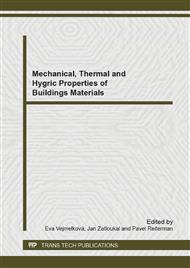[1]
Komonen, J., Penttala, 2003, V., Effects of high temperature on the pore structure and strength of plain and polypropylene fiber reinforced cement pastes, Fire Technology, Vol. 39, pp.23-34.
Google Scholar
[2]
Černý, R. et al., 2004, Hygrothermal Properties of Glass Fiber Reinforced Cements Subjected to Elevated Temperature. Materials and Structures, Vol. 37, pp.597-607.
DOI: 10.1617/14019
Google Scholar
[3]
Li, Z.J., Zhou, X.M., Shen, B., 2004, Fiber-cement extrudates with perlite subjected to high temperatures. Journal of Materials in Civil Engineering, Vol. 16, 221-229.
DOI: 10.1061/(asce)0899-1561(2004)16:3(221)
Google Scholar
[4]
Peng, G.F., Yang, W.W., Zhao, H., Liu, Y.F., Bian, S.H., Zhao, L.H., 2006, Explosive spalling and residual mechanical properties of fiber-toughened high-performance concrete subjected to high temperatures . Cement and Concrete Research, Vol. 36, 723-727.
DOI: 10.1016/j.cemconres.2005.12.014
Google Scholar
[5]
Černý, R., Němečková, J., Rovnaníková, P., Bayer P., 2007, Effect of thermal decomposition processes on the thermal properties of carbon fiber reinforced cement composites in high-temperature range. Journal of Thermal Analysis and Calorimetry, Vol. 90, 475-488.
DOI: 10.1007/s10973-006-7944-0
Google Scholar
[6]
Holčapek, O. - Reiterman, P. - Konvalinka, P.: High Temperature Composite of Aluminous Cement with Addition of Metakaolin and Ground Bricks Dust. In Experimental Stress Analysis 51. Uetikon- Zurich: Trans Tech Publications, 2014, pp.406-411.
DOI: 10.4028/www.scientific.net/amm.486.406
Google Scholar
[7]
Reiterman, P., Holčapek, O., Čáchová M., Vogel, F., Jogl, M., Konvalinka, P., 2014, Basic and Hygric Properties of Concrete Containing Fine Ceramic Powder, Advanced Materials Research, Vol. 897, pp.188-191.
DOI: 10.4028/www.scientific.net/amr.897.188
Google Scholar
[8]
Reiterman, P., Holčapek, O., Vogel, F., Jogl, M., Koťátková, J., 2014, Fracture and Mechanical Properties of Fire Resistant Fibre Composites Containing Fine Ground Ceramic Powder, Advanced Materials Research, Vol. 897, pp.192-195.
DOI: 10.4028/www.scientific.net/amr.897.192
Google Scholar
[9]
Helwlett, P., Lea's Chemistry of Cement and Concrete, Butterworth-Heinemann, (2003).
Google Scholar
[10]
Roels, S., Carmeliet. J., Hens. H., Adan. O., Brocken, H., Černý, R., Pavlík, Z., Hall, C., Kumaran, K., Pel, L., Plagge, R. Interlaboratory Comparison of Hygric Properties of Porous Building Materials. Journal of Thermal Envelope and Building Science 2004, Vol. 27, pp.307-325.
DOI: 10.1177/1097196304042119
Google Scholar
[11]
Kumaran M. K.: Moisture Diffusivity of Building Materials from Water Absorption Measurements. Journal of Thermal Envelope and Building Science. 1999, Vol. 22, pp.349-355.
DOI: 10.1177/109719639902200409
Google Scholar
[12]
Vejmelkova, E., Pavlikova, M., Jerman, M., et al., 2009, Free Water Intake as Means of Material Characterization, Journal of building physics, Vol. 33, No. 1, pp.29-44.
Google Scholar
[13]
Applied Precision - ISOMET. [User manual], Bratislava (1999).
Google Scholar


